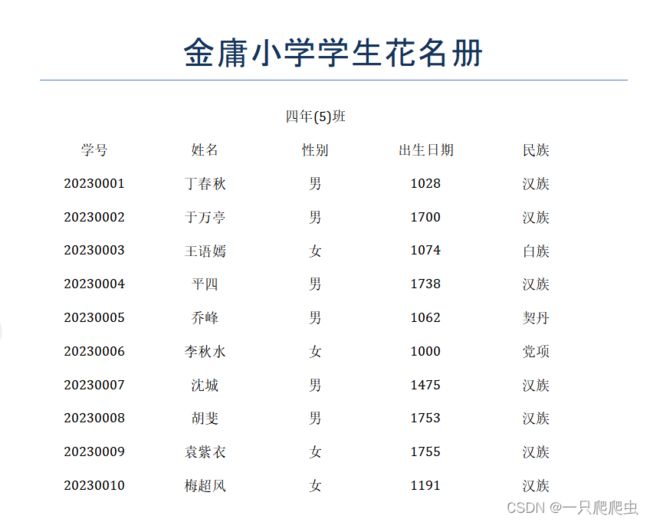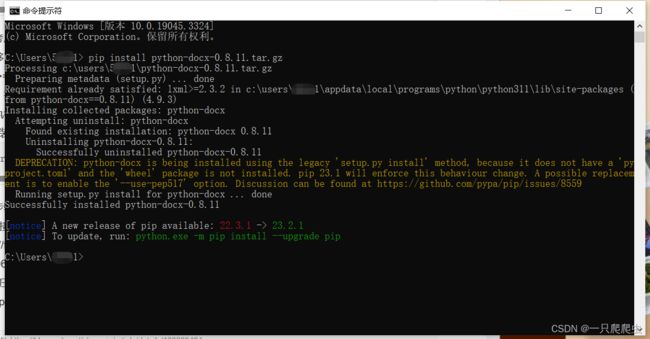【Python】利用python-docx生成word版本学生花名册
如图,可以用python创建word文档,生成一个学生的花名册。生成的过程:先下载第三方依赖包,安装依赖包,然后引入依赖文件,创建docx文件,添加标题,创建表头,创建表格正文,居中填写表头内容、项目行、表格正文。
目录
一、安装Python-docx包
(一)下载
1、官网下载
2、下载步骤
(二)安装步骤
二、文件格式
(一)标题栏
(二)表格
1、表头
2、项目行
3、表格正文
三、python-docx中表格相关知识
(一)表格设计
1、表格框架
2、单元格
3、段落
(二)表格内容居中
1、水平居中
2、垂直居中
四、完整程序代码
(一)引入依赖
(二)声明学生花名册相关变量
(三)最终代码
一、安装Python-docx包
(一)下载
1、官网下载
官网网址:python-docx · PyPI
2、下载步骤
点击Download files,点击python-docx-0.8.11.tar.gz压缩包开始下载。
(二)安装步骤
打开cmd命令行窗口,把刚刚下载的python-docx-0.8.11.tar.gz压缩包复制到命令行窗口默认的目录下,一般都是C:\Users\****>。
在命令行输入pip install python-docx-0.8.11.tar.gz后回车,执行完安装的结果如下图:
二、文件格式
(一)标题栏
word文档设定一个标题栏,标题为“金庸小学学生花名册”。
(二)表格
1、表头
表头为1行1列,是表格的名称“四年(5)班”。
2、项目行
学生花名册一共有学号、姓名、性别、出生日期、民族5个项目,项目行为1行5列。
3、表格正文
表格正文为10个学生的具体信息,为10行5列。
三、python-docx中表格相关知识
(一)表格设计
1、表格框架
因为表头和项目行、表格正文格式不一样,所以需要创建两个表格,1个为1行1列的表格table1,1个为11行5列的表格table2。
python-docx中创建表格的方法为add_table(行数,列数)
# 创建表头
table1=document.add_table(1,1)
# 创建表格
table2=document.add_table(11,5)2、单元格
python-docx中表格中的单元格为table.cell(行序号,列序号)。
3、段落
python-docx中表格中的单元格中的文字内容为段落,为table.cell(行序号,列序号).paragraphs[段落序号]。
(二)表格内容居中
1、水平居中
table1.cell(0,0).paragraphs[0].paragraph_format.alignment = WD_TABLE_ALIGNMENT.CENTER2、垂直居中
因为每个表格里创建的是一个段落,段落行距离,有段前、段后距离,可以设置段前、段后的距离等于行距的一半即可以完成垂直居中。
table1.cell(0,0).paragraphs[0].paragraph_format.line_spacing = Pt(12)
table1.cell(0,0).paragraphs[0].paragraph_format.space_before = Pt(6)
table1.cell(0,0).paragraphs[0].paragraph_format.space_after = Pt(6)四、完整程序代码
(一)引入依赖
#引入word文件包
from docx import Document
#引入表格对齐文件包
from docx.enum.table import WD_TABLE_ALIGNMENT
#引入表格段落对齐文件包
from docx.enum.text import WD_PARAGRAPH_ALIGNMENT
#引入英尺、磅尺寸文件包
from docx.shared import Inches,Pt
#引入表格单元格水平对齐文件包
from docx.enum.table import WD_CELL_VERTICAL_ALIGNMENT(二)声明学生花名册相关变量
# 学生学号起始编号
student_no=20230001
# 花名册项目名称
student_item = ["学号","姓名","性别","出生日期","民族"]
# 学生姓名列表
student_name = ["丁春秋","于万亭","王语嫣","平四","乔峰","李秋水","沈城","胡斐","袁紫衣","梅超风"]
# 学生民族列表
student_ethnic = ["汉族","汉族","白族","汉族","契丹","党项","汉族","汉族","汉族","汉族"]
# 学生性别列表
student_gender = ["男","男","女","男","男","女","男","男","女","女"]
# 学生出生年代列表
student_birthday = [1028,1700,1074,1738,1062,1000,1475,1753,1755,1191](三)最终代码
#引入word文件包
from docx import Document
#引入表格对齐文件包
from docx.enum.table import WD_TABLE_ALIGNMENT
#引入表格段落对齐文件包
from docx.enum.text import WD_PARAGRAPH_ALIGNMENT
#引入英尺、磅尺寸文件包
from docx.shared import Inches,Pt
#引入表格单元格水平对齐文件包
from docx.enum.table import WD_CELL_VERTICAL_ALIGNMENT
# 学生学号起始编号
student_no=20230001
# 花名册项目名称
student_item = ["学号","姓名","性别","出生日期","民族"]
# 学生姓名列表
student_name = ["丁春秋","于万亭","王语嫣","平四","乔峰","李秋水","沈城","胡斐","袁紫衣","梅超风"]
# 学生民族列表
student_ethnic = ["汉族","汉族","白族","汉族","契丹","党项","汉族","汉族","汉族","汉族"]
# 学生性别列表
student_gender = ["男","男","女","男","男","女","男","男","女","女"]
# 学生出生年代列表
student_birthday = [1028,1700,1074,1738,1062,1000,1475,1753,1755,1191]
# 创建文件
document = Document()
# 添加标题
h=document.add_heading('金庸小学学生花名册',0)
# 标题居中
h.paragraph_format.alignment = WD_PARAGRAPH_ALIGNMENT.CENTER
# 创建表头
table1=document.add_table(1,1)
# 创建表格
table2=document.add_table(11,5)
# 填写表头内容
table1.cell(0,0).text="四年(5)班"
# 表头内容格式:行间距12磅,段前6磅,段后6磅,也就是竖直居中
table1.cell(0,0).paragraphs[0].paragraph_format.line_spacing = Pt(12)
table1.cell(0,0).paragraphs[0].paragraph_format.space_before = Pt(6)
table1.cell(0,0).paragraphs[0].paragraph_format.space_after = Pt(6)
# 表头内容格式:水平居中
table1.cell(0,0).paragraphs[0].paragraph_format.alignment = WD_TABLE_ALIGNMENT.CENTER # 水平居中
# 填写项目名称行
for i in range(5):
table2.cell(0,i).text=student_item[i]
table2.cell(0,i).paragraphs[0].paragraph_format.line_spacing = Pt(12)
table2.cell(0,i).paragraphs[0].paragraph_format.space_before = Pt(6)
table2.cell(0,i).paragraphs[0].paragraph_format.space_after = Pt(6)
table2.cell(0,i).paragraphs[0].paragraph_format.alignment = WD_TABLE_ALIGNMENT.CENTER # 水平居中
# 填写学号列
for j in range(1,11):
table2.cell(j,0).text=str(student_no+j-1)
table2.cell(j,0).paragraphs[0].paragraph_format.line_spacing = Pt(12)
table2.cell(j,0).paragraphs[0].paragraph_format.space_before = Pt(6)
table2.cell(j,0).paragraphs[0].paragraph_format.space_after = Pt(6)
table2.cell(j,0).paragraphs[0].paragraph_format.alignment = WD_TABLE_ALIGNMENT.CENTER # 水平居中
# 填写姓名列
for j in range(1,11):
table2.cell(j,1).text=sudent_name[j-1]
table2.cell(j,1).paragraphs[0].paragraph_format.line_spacing = Pt(12)
table2.cell(j,1).paragraphs[0].paragraph_format.space_before = Pt(6)
table2.cell(j,1).paragraphs[0].paragraph_format.space_after = Pt(6)
table2.cell(j,1).paragraphs[0].paragraph_format.alignment = WD_TABLE_ALIGNMENT.CENTER # 水平居中
# 填写性别列
for j in range(1,11):
table2.cell(j,2).text=sudent_gender[j-1]
table2.cell(j,2).paragraphs[0].paragraph_format.line_spacing = Pt(12)
table2.cell(j,2).paragraphs[0].paragraph_format.space_before = Pt(6)
table2.cell(j,2).paragraphs[0].paragraph_format.space_after = Pt(6)
table2.cell(j,2).paragraphs[0].paragraph_format.alignment = WD_TABLE_ALIGNMENT.CENTER # 水平居中
# 填写出生年代列
for j in range(10):
table2.cell(j,3).text=str(student_birthday[j])
table2.cell(j,3).paragraphs[0].paragraph_format.line_spacing = Pt(12)
table2.cell(j,3).paragraphs[0].paragraph_format.space_before = Pt(6)
table2.cell(j,3).paragraphs[0].paragraph_format.space_after = Pt(6)
table2.cell(j,3).paragraphs[0].paragraph_format.alignment = WD_TABLE_ALIGNMENT.CENTER # 水平居中
# 填写民族列
for j in range(1,11):
table2.cell(j,4).text=sudent_ethnic[j-1]
table2.cell(j,4).paragraphs[0].paragraph_format.line_spacing = Pt(12)
table2.cell(j,4).paragraphs[0].paragraph_format.space_before = Pt(6)
table2.cell(j,4).paragraphs[0].paragraph_format.space_after = Pt(6)
table2.cell(j,4).paragraphs[0].paragraph_format.alignment = WD_TABLE_ALIGNMENT.CENTER # 水平居中
# 保存文档
document.save('student.docx')
(全文完)



